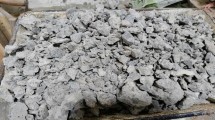Abstract
The results of a test programme to study the use of recycled concrete aggregate (RCA) in high-strength, 50 N/mm2 or greater, concrete are described. The effects of coarse RCA content on the ceiling strength, bulk engineering and durability properties of such concretes have been established. The results showed that up to 30% coarse RCA had no effect on concrete strength, but therafter there was a gradual reduction as the RCA content increased. A method of accommodating the effects of high RCA content, involving simple adjustment to water/cement ratio of the mix is given. It is shown that high-strength RCA concrete will have equivalent engineering and durability performance to concrete made with natural aggregates, for corresponding 28-day design strengths. The practical implications of the study for concrete construction are discussed.
Résumé
Sont décrits ici les résultats d’une série d’essais destinés à étudier l’utilisation de granulats provenant du recyclage d’éléments en béton (RCA) dans des bétons de haute résistance (50 MPa et plus). Les effets de la teneur en gros granulats recyclés sur la résistance des plafonds et des bâtiments, ainsi que les propriétés de tels bétons ont été établis. Les résultats ont montré qu’une teneur allant jusqu’à 30% en gros granulats recyclés n’a pas d’effet sur la résistance du béton, mais qu’au dessus de 30%, la résistance diminue progressivement à mesure que la teneur en gros granulats recyclés augmente. Une méthode visant à accommoder les effets dus à une forte proportion de RCA, nécessitant un simple ajustement du rapport eau/ciment dans le mélange, est proposée. Il est prouvé que le béton RCA de haute résistance aura des qualités de résistance et de durabilité équivalentes à celles de bétons constitués de granulats naturels, pour les résistances mécaniques à 28 jours prévues. Les implications pratiques de l’étude sur la réalisation d’ouvrages en béton sont présentées.
Similar content being viewed by others
References
British Department of the Environment, ‘Managing demolition and construction wastes: Report of the study on the recycling of demolition and construction wastes in the UK’, HMSO, London (1994).
Speare, R. S., ‘Recycling of structural materials’,The Structural Engineer 73 (13) (1995) 220–222.
Lauritzen, E. K., ‘The global challenge of recycled concrete’, Sustainable Construction: Use of Recycled Concrete Aggregate, Proceedings of an International Symposium, London, Nov. 1998 (Thomas Tclford, London, 1998) 505–519.
Hansen, T. C., Recycling of demolished concrete and masonry, RILEM Report No. 6, (E & FN Spon, London, 1992).
Collins, R. J., ‘Recycled aggregate in ready mix’,Concrete Engineering International (1998) 49–54.
Dhir, R. K., Limbachiya, M. C. and Leelawat, T., ‘Suitability of recycled concrete aggregate for use in BS 5328 Designated mixes’, Proceedings of ICE:Structures & Buildings 134 (3) (Aug. 1999) 257–274.
Limbachiya, M. C., Leelawat, T. and Dhir, R. K., ‘RCA Concrete: A study of properties in the fresh state, strength development and durability’, Sustainable Construction: Use of Recycled Concrete Aggregate, Proceedings of an International Symposium, London, Nov. 1998, (Thomas Telford, London, 1998) 227–238.
Acker, Van A., ‘Recycling of concrete at a precast concrete plant: Part 1’,FIP notes (1997/3) 3–6.
Kikuchi, K., Yasunaga, A. and Ehara, K., ‘The total evaluation of recycled aggregated and recycled concrete’, Proceedings of 3rd Int. RILEM Symp. Demolition and Reuse of Concrete & Masonry, Odense, Denmark (E & FN Spon, London, Oct. 1993) 367–377.
Ravindrajah, S. R., Loo, Y. H. and Tam, C. T. ‘Strength evaluation of recycled-aggregate concrete by in-situ tests’,Mater. Struct. 21 (1988) 289–295.
British Standard Institution, ‘BS 882 Specification for aggregate from natural resources for concrete’ (London, 1992).
British Standard Institution, ‘BS 12, Specification for Portland cement’, (London, 1996).
British Standard Institution, 4BS 5075, Pt. 3, Specification for superplasticising’ (London, 1985).
British Standard Institution, ‘BS 5075, Pt. 2, Specification for airm entraining admixtures’, (London, 1982).
Teychenne, D. C., Franklin, R. E. and Erntroy, H. C., ‘Design of normal concrete mixes’,Building Research Establishment (1988).
British Standard Institution, ‘BS 1881, Part 118, Method for determination of flexural strength’, (London, 1983).
British Standard Institution, ‘BS 1881, Part 121, Method for determination of static modulus of elasticity in compression’ (London, 1983).
Ravindrajah, S. R. and Tam, C. T., ‘Properties of concrete made with crushed concrete as coarse aggregate’,Magazine of Concrete Research 37 (130) (1985) 29–38.
De Pauw, P, Thomas, P., Vyncke, J. and Desmyter, J., ‘Shrinkage and creep of concrete with recycled materials as coarse aggregates’, Sustainable Construction: Use of Recycled Concrete Aggregate, Proceedings of an International Symposium, London, Nov. 1998, (Thomas Telford, London, 1998) 213–226.
British Standard Institution, ‘BS 1881, Part 208, Testing for concrete: REcommendations for the determination of the initial surface absorption of concrete’, (London, 1996).
Dhir, R. K., Hewlett, P. C. and Chan, Y. N., ‘Near surface characteristics of concrete: intrinsic permeability’,Magazine of Concrete Research 41 (147) (1989) 87–97.
Dhir, R. K., Limbachiya, M. C. and Leelawat, T., ‘Recycled concrete aggregate for use in BS5328 designated mixes’, DETR Report CTU/498 (University of Dundee, Jan. 1998).
Dhir, R. K., Jones, M. R., Ahmed, H. E. H. and Seneviratne, A. M. G., ‘Rapid estimation of chloride diffusion coefficient in concrete’,Magazine of Concrete Research 42 (152) (1990) 177–185.
Dhir, R. K., Jones, M. R. and McCarthy, M. J., ‘PFA concrete: chloride-induced reinforcement corrosion’,Magazine of Concrete Research 46 (169) (1994) 269–277.
Gonzalez, J. A.,et al., ‘Corrosion rate of reinforcements during accelerated carbonation of mortar made with different type of cement’ Corrosion of reinforcement in concrete construction, (Ellis Horwood, London 1983), 159–174.
American Society for Testing and Materials, ‘C666; Standard test for resistance of concrete to freezing and thawing’ (1988).
British Standard Institution, ‘BS 1881, Part 203, Recommendations for measurement of ultrasonic pulses in concrete’ (London, 1986).
British Standard Institution, ‘BS 5328, Part 1 Guide to specifying concrete’ (London, 1991).
Dhir, R. K., Hewlett, P. C. and Chan, Y. N., ‘Near surface characteristics of concrete: Abrasion resistance’,Mater. Struct. 24 (1991) 122–128.
Author information
Authors and Affiliations
Rights and permissions
About this article
Cite this article
Limbachiya, M.C., Leelawat, T. & Dhir, R.K. Use of recycled concrete aggregate in high-strength concrete. Mat. Struct. 33, 574–580 (2000). https://doi.org/10.1007/BF02480538
Received:
Accepted:
Issue Date:
DOI: https://doi.org/10.1007/BF02480538




